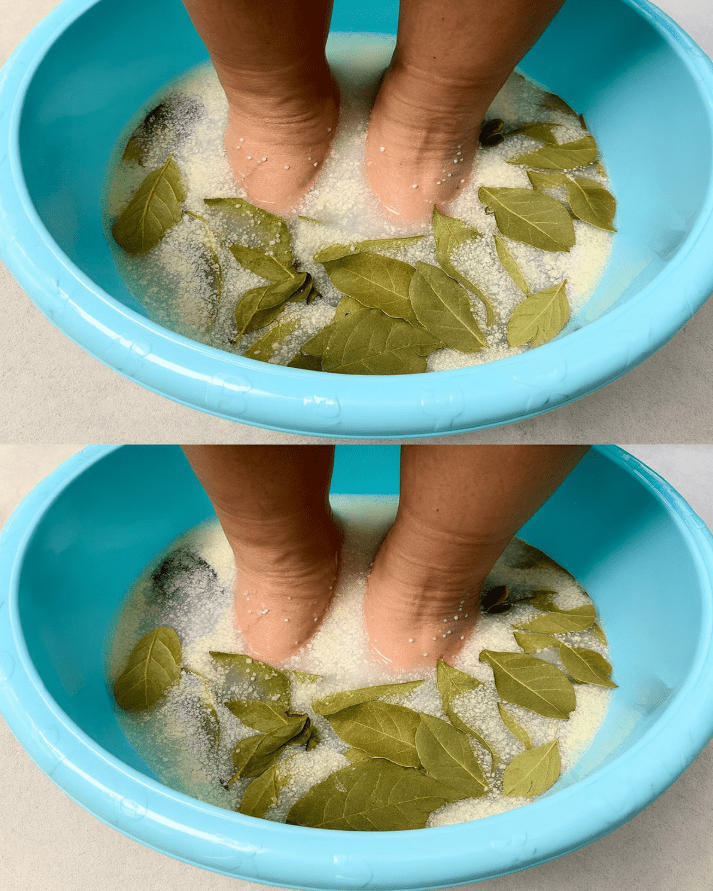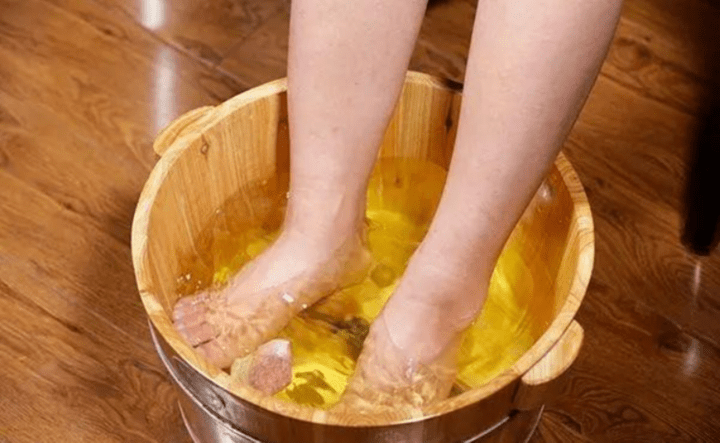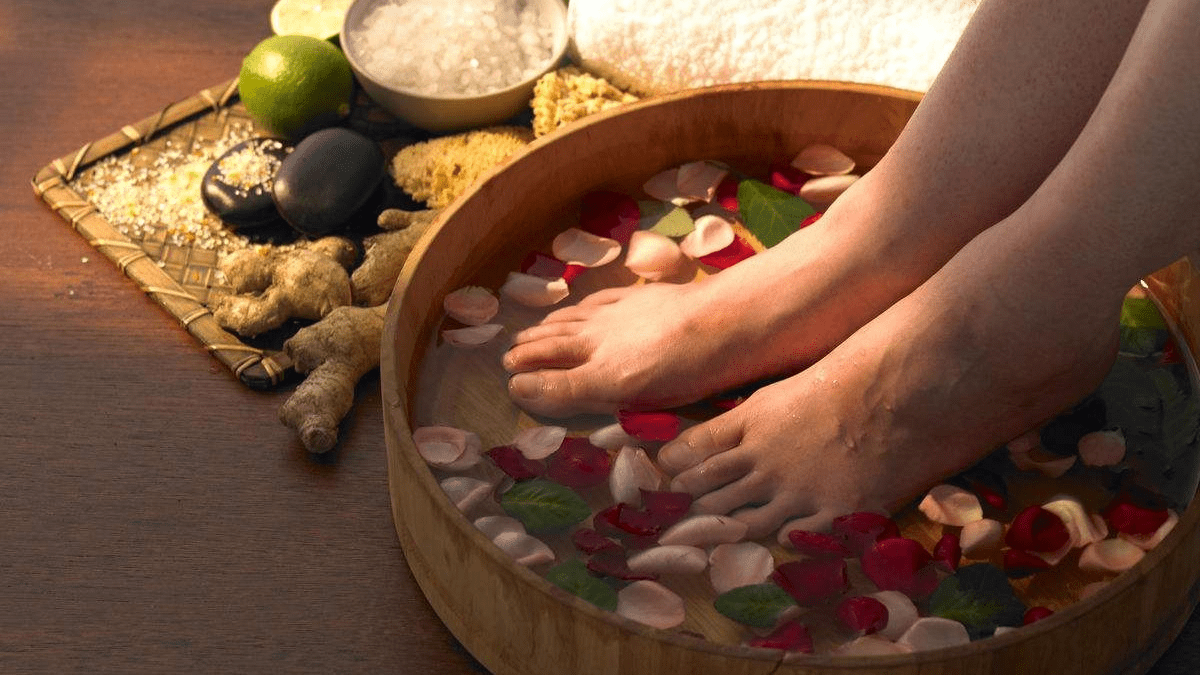
Stronger Than Garlic and Lemon: The Bay Leaf Foot Soak That Removes Toxins and Bacteria

For centuries, natural remedies have been used to cleanse the body, soothe discomfort, and support overall wellness. While garlic and lemon are often praised for their antimicrobial and detoxifying properties, there’s another traditional ingredient that deserves attention: bay leaves.

Most people know bay leaves as a fragrant spice for soups and stews, but in traditional wellness practices, bay leaves have also been used in teas, oils, and even foot soaks. The feet—home to thousands of nerve endings and sweat glands—are an important channel for relaxation and detox rituals across many cultures.
A bay leaf foot soak is believed to help remove bacteria, reduce foot odor, ease swelling, and even promote better sleep. While research on “detox through feet” is still debated in modern science, the soothing and antimicrobial effects of bay leaves, combined with the calming act of soaking, may offer real benefits for seniors and anyone seeking natural support.
In this article, we’ll explore why bay leaves are considered “stronger than garlic and lemon” in certain folk traditions, how to prepare a foot soak at home, and what kind of results to expect.
Why Bay Leaves Are Linked to Cleansing and Antimicrobial Power
1. Antibacterial and Antifungal Properties
Bay leaves contain compounds like cineole, linalool, and eugenol, which exhibit antimicrobial activity. These compounds may help reduce bacterial and fungal growth on the feet—common issues for seniors and people with diabetes.
2. Anti-Inflammatory Effects
Bay leaf essential oils have been used traditionally to soothe joint pain, swelling, and inflammation. A warm soak may help relax sore feet and ease mild discomfort from arthritis or long hours of standing.

3. Circulation Support
Warm water alone boosts circulation, but when combined with the aromatic oils of bay leaves, it can further stimulate blood flow in the legs and feet—an area where circulation often weakens with age.
Garlic & Lemon vs. Bay Leaf
- Garlic: Strong antibacterial but pungent and irritating on skin.
- Lemon: Antiseptic but acidic, which may cause dryness.
- Bay leaf: Gentler on skin, aromatic, and provides both antimicrobial and anti-inflammatory support.
How to Make a Bay Leaf Foot Soak
Ingredients:
- 5–7 dried bay leaves
- 1–2 liters of hot water
- Optional: 1 tablespoon sea salt or Epsom salt
Instructions:
- Boil the bay leaves in water for 10 minutes.
- Pour into a large basin and let cool slightly.
- Add salt if desired for extra cleansing effect.
- Soak your feet for 15–20 minutes.
- Dry thoroughly, especially between toes, to prevent fungal growth.
Tips for Best Results:

- Do the soak before bed to promote relaxation.
- Repeat 2–3 times per week.
- Always check water temperature to avoid burns, especially if you have reduced sensation in your feet.
Before and After: What to Expect
Before:
- Tired, swollen, or smelly feet
- Mild irritation or fungal issues
- Trouble relaxing at night
After several soaks:
- Fresher-smelling, cleaner feet
- Reduced swelling and mild discomfort
- A sense of calm and better sleep quality
While the soak won’t literally “pull toxins out of your body,” it can improve hygiene, relaxation, and circulation—benefits that contribute to overall health and comfort.
Case Study: A Senior’s Routine

Marjorie, age 71, had struggled with foot odor and swelling after daily walks. Instead of relying solely on medicated sprays, she tried a bay leaf soak three nights a week. Within a month, she noticed fresher feet, less swelling, and a soothing ritual that helped her wind down before bed. She still follows her doctor’s advice for circulation care, but the soak remains her favorite self-care routine.
Additional Benefits of Bay Leaf Foot Soaks
- Natural deodorizer for feet
- Stress relief through aromatherapy
- May support healthier toenails by reducing fungal load
- Enhances bedtime relaxation ritual
Conclusion and FAQs
Key Takeaways
- Bay leaves contain natural antimicrobial and anti-inflammatory compounds.
- A foot soak with bay leaves can help cleanse, refresh, and relax tired feet.
- While it won’t cure medical conditions, it can be a valuable part of self-care for seniors and adults alike.
FAQs
Can a bay leaf foot soak cure fungal infections?
It may reduce fungal growth but cannot replace medical treatment for severe infections.
How often should I do this soak?
2–3 times per week is safe for most people.
Is it safe for diabetics?
Yes, but diabetics should check water temperature carefully and consult their doctor before trying new foot remedies.
Can I use fresh bay leaves instead of dried?
Yes. Fresh leaves may release even more aroma and beneficial oils.
Disclaimer: This article is for informational purposes only. It does not substitute medical advice. Always consult your healthcare provider for proper diagnosis and treatment.
News in the same category


How to Make the Perfect Pineapple, Turmeric, Carrot, and Lemon Juice for an Immune Boost

Mix Watermelon and Coffee for a Surprising Boost of Energy and Refreshment

Beetroot Juice: A Gentle Ally for Women’s Reproductive and Menstrual Health

The Best Tea for Mornings and After Dinner: A Surprising Herbal Blend

The Surprising Blackhead Hack You’ll Wish You Knew Sooner: Toothpaste in Just 5 Minutes!

Unleash Your Inner Strength: Natural Ways to Boost Testosterone and Vitality After 50

Plantago Major: The Humble “Weed” Packed with Healing Superpowers

Two Bananas a Day: The Simple Habit That Transforms Your Body and Mind

Discover the Secret Superpower of Goosegrass: Nature’s Kidney-Boosting Marvel

Cloves: The Tiny Spice That Conquers Sore Throats and Inflammation Naturally

Taro Root Unleashed: The Tropical Treasure That Transforms Your Health and Kitchen

Unleash Your Inner Fire: The Banana-Coffee Combo That’ll Supercharge Your Day!

Unlock the Hidden Power of Corn Silk: 30 Surprising Health Benefits You Need to Know

Datura Stramonium: Miracle Herb or Deadly Danger? Uncover Its Secrets!

Revive Your Power: A Natural Blend for Men Over 40 to Reclaim Strength and Vitality

Unlock the Secret to Luscious Locks: DIY Onion Hair Oil for Stunning Hair Growth

Discover the Vision-Boosting Power of Carrot, Ginger, and Lemon Juice

Goosegrass: The Secret Superweed You’ll Wish You Knew Sooner! 7 Reasons to Embrace It in Your Garden

Unveil the Mystery: 10 Japanese Rice-Based Secrets for Radiant, Wrinkle-Free Skin
News Post

🍎 Apple Cider Vinegar Foot Soak: Benefits, Risks & What Science Says

Beets and Kidney Health: A Natural Tip for Later Years

11 Signs Your Body Is Giving You Important Alerts

Ginger and Orange Peel Tea – A Natural Cleanse for Kidneys, Liver, and Lungs

How to Make the Perfect Pineapple, Turmeric, Carrot, and Lemon Juice for an Immune Boost

Mix Watermelon and Coffee for a Surprising Boost of Energy and Refreshment

Beetroot Juice: A Gentle Ally for Women’s Reproductive and Menstrual Health

The Best Tea for Mornings and After Dinner: A Surprising Herbal Blend

The Surprising Blackhead Hack You’ll Wish You Knew Sooner: Toothpaste in Just 5 Minutes!

Unleash Your Inner Strength: Natural Ways to Boost Testosterone and Vitality After 50

The Truth About Turtle Shells: Not Just a Home, But Their Body

Plantago Major: The Humble “Weed” Packed with Healing Superpowers

Two Bananas a Day: The Simple Habit That Transforms Your Body and Mind

Discover the Secret Superpower of Goosegrass: Nature’s Kidney-Boosting Marvel

Cloves: The Tiny Spice That Conquers Sore Throats and Inflammation Naturally

Taro Root Unleashed: The Tropical Treasure That Transforms Your Health and Kitchen

Unleash Your Inner Fire: The Banana-Coffee Combo That’ll Supercharge Your Day!

Unlock the Hidden Power of Corn Silk: 30 Surprising Health Benefits You Need to Know

Datura Stramonium: Miracle Herb or Deadly Danger? Uncover Its Secrets!
